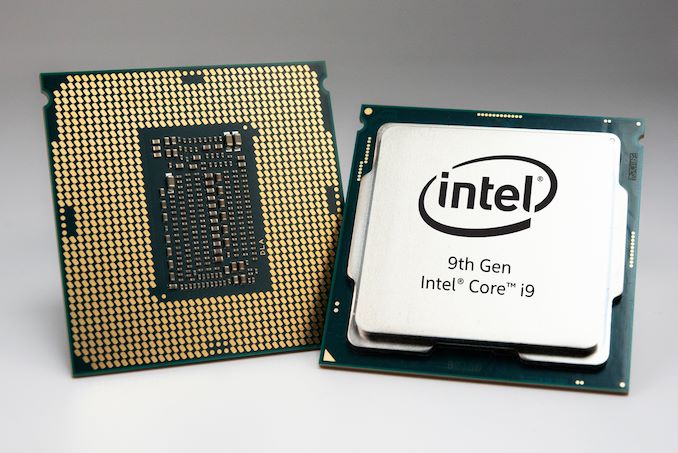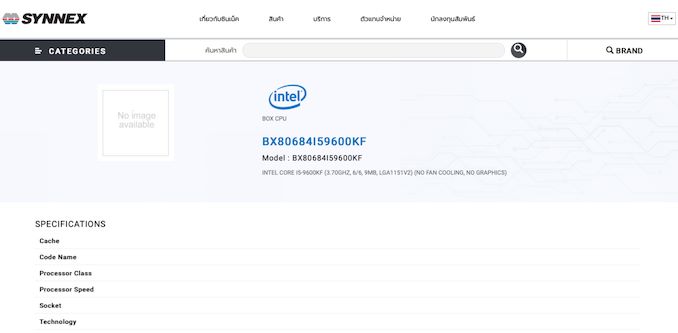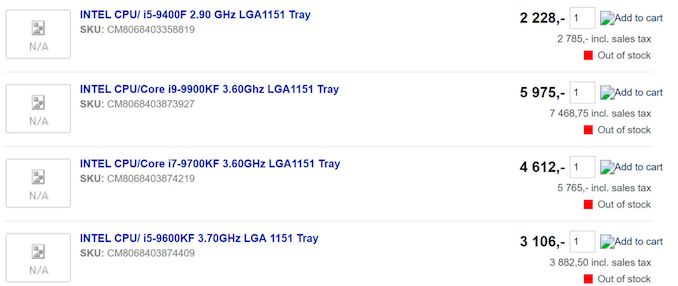Unannounced Intel Core i9-9900KF, i7-9700KF, i5-9600KF and i5-9400F CPUs Listed
by Anton Shilov on December 28, 2018 5:00 PM EST- Posted in
- CPUs
- Intel
- Coffee Lake
- Core 9th Gen

So far Intel's 9th Gen Core on desktop only features three models aimed at the higher end of the spectrum. The launch of the lineup consisting of these three products with unlocked multiplier does not yet have any “locked” parts aimed at mainstream PCs, although we are expecting them at some point. The question is one of when they will come. As it appears, from listings of numerous companies in the supply chain, Intel is finally gearing up to expand its Coffee Lake Refresh family with new models.
The products in question are the eight-core Core i9-9900KF and Core i7-9700KF, as well as the six-core Core i5-9600KF and Core i5-9400F. These devices have been listed by retailers Data-Systems.Fi, Newegg, and distributor Synnex (see screenshots below). According to Intel’s existing nomenclature, the CPUs with model numbers ending with F, like 9400F lack integrated graphics, so we suspect the new processors will primarily target higher-end systems featuring discrete graphics. This will mark the first time that Intel has launched integrated graphics-free processors in its mainstream family at the high-end for many, many years.
The higher-end Core i9-9900KF, Core i7-9700KF, and Core i5-9600KF look set to run at the same frequencies and feature the same cache configurations as their non-F colleagues. As for the Core i5-9400F, this six-core chip runs at 2.9/4.1 GHz, well below the clocks of the i5-9600K, but will have a TDP of 65 W. All of these parts, according to the listings, will be able to be used in current 300-series motherboards.
| Intel's 9th Gen Core Processors for LGA1151 v2 | ||||||||
| AnandTech | Cores | TDP | Freq | L3 | DRAM DDR4 |
iGPU | iGPU Turbo |
|
| Core i9-9900K | $488 | 8 / 16 | 95 W | 3.6 / 5.0 | 16 MB | 2666 | GT2 | 1200 |
| Core i9-9900KF* | ? | - | - | |||||
| Core i7-9700K | $374 | 8 / 8 | 95 W | 3.6 / 4.9 | 12 MB | 2666 | GT2 | 1200 |
| Core i7-9700KF* | ? | - | - | |||||
| Core i5-9600K | $262 | 6 / 6 | 95 W | 3.7 / 4.6 | 9 MB | 2666 | GT2 | 1150 |
| Core i5-9600KF* | ? | - | - | |||||
| Core i5-9400F | ? | 6 / 6 | 65 W | 2.9 / 4.1 | 9 MB | 2666 | - | - |
| *These CPUs has not been launched officially, specifications have not been confirmed. | ||||||||
Intel has not officially confirmed existence of these CPUs, or mentioned plans to release them. In the meantime, listing of the Core i5-9600KF by Newegg and the Core i5-9400F by Synnex Thailand indicates that their launch is likely imminent. Avid readers will remember that CES 2019 is taking place in early January, so the question is whether Intel starts to sell these CPUs more or less quietly ahead of CES, or if it will announce them publicly at the trade show.
In any case, if Intel proceeds with the launch (or rather when), it may broaden availability of its latest eight-core and six-core CPUs both in terms of physical availability and in terms of pricing (i.e., the i9-9900KF will hopefully cost less than the i9-9900K). In the meantime, one has to remember that Intel has high demand issues in general, so the effect of the launch is something that remains to be seen. It could be that the company will not focus on the Pentium/Celeron parts this time around, but instead make these higher-performing (and higher margin) offerings more regular.
Screenshots:
Related Reading:
- The Intel 9th Gen Review: Core i9-9900K, Core i7-9700K and Core i5-9600K Tested
- Analyzing Core i9-9900K Performance with Spectre and Meltdown Hardware Mitigations
- Intel Announces 9th Gen Core CPUs: Core i9-9900K (8-Core), i7-9700K, & i5-9600K
- Intel Coffee Lake Refresh: Global Price Check on 9900K, 9700K, 9600K
Source: Newegg, Synnex, Tom’s Hardware














60 Comments
View All Comments
HStewart - Saturday, December 29, 2018 - link
I was curious why some models have no hyperthreading, but 8 cores without HT.Just maybe people on finding out you really don't need that many cores and that it better to have faster cores instead.
CPU's manufactures have gotten sloppy - instead improving the architexture - they just add more cores - I exited about Sunny Cove, because this means architecture is independent of Node process.
Now also Memory, more memory now a days means developers ( which I am one ), can be sloppy in their programming - in stead count clock cycles they and optimizing access techniques - they can load data structures in memory and just depend on more memory.
bug77 - Monday, December 31, 2018 - link
In the old days, there was just one dimension to CPUs: the speed of a single core. Back then, it was possible to order CPUs from slowest to fastest.Now the problem has more dimensions: core count and even boost clocks (and how long they can be sustained). Today it's no longer possible to define a single metric by which one CPU is faster than another. It all depends on your typical workload.
And yes, as you suspected, many workloads don't actually need that many physical cores.
imaheadcase - Saturday, December 29, 2018 - link
Right /rolls eyes.FullmetalTitan - Friday, December 28, 2018 - link
One might be forgiven for thinking Intel would have launched this lineup without iGPU from the start, as that would potentially mean a smaller die, and therefore better yields/more die per wafer. But this is not exactly Intel's best few years of thinking ahead or adapting, so it makes sense they would completely miss the low hanging fruit solution to some of their supply issues, a solution AMD has been using already with high end parts that are EXPECTED to be paired with a discrete graphics device.FullmetalTitan - Friday, December 28, 2018 - link
It is also possible, of course, that these are simply salvaged die from the original design where defects were restricted to the iGPU portion of silicon, and therefore just have the block disabled. That consideration aside, my point stands that Intel missed an option to ease their supply woes months earlierDanNeely - Friday, December 28, 2018 - link
These're almost certainly die salvages not new design. I'll be interesting to see what availability looks like, depending on how low it is they might not've done it sooner because it took until now to have a worthwhile number of dead GPU chips to create the SKUs. Unlike the smaller mobile chips, the big desktop one's don't have a lot of GPU area on the die; so CPUs with good compute cores, cache, etc, but a busted GPU are probably relatively rare.shompa - Saturday, December 29, 2018 - link
Die salvages have for 4 years been i5/i3. That's why these "salvages" are just marginally cheaper than the full version. Intel did not throw away these CPUs before, just branded differently in the fake segmentation that Intel does.Intel's supply problem is not like the narrative says "unprecedented demand". The real story is that Intel has 2-3 14nm fabs that are at 100% capacity. When Intel starts adding more cores/die area = they actually manufacture less complete chips to sell. Intel thought 10nm would be online so there is simply no fab space when Intel added more cores to "compete" with AMD. The funny thing with "shortages" is also that Intel can charge more for their CPUs, so why should they care about producing more? (if we instead used ARMs we would complain about 8 core CPUs that cost 25-50 dollars. But somehow people are brainwashed that X86 prices are "normal" and that X86 is the "fastest", something it never has been. It's not even real 64bit, something RISC was in 1990. heck, you can't even run 32bit code on A SoCs today since there is no 32bit. Good luck trying to do this on X86. (you cant remove the 32bit registers since 64bit are extensions. Fake 64bit = why X86 is the ONLY CPU that did not show performance increase going from 32 to 64bit. Instead 3% decrease. Compile the same app in 32bit/64bit and run on A7 and you see the usual 30-40% speed increase going to 64bit. We REALLY need to move away from X86...
Santoval - Saturday, December 29, 2018 - link
"The funny thing with "shortages" is also that Intel can charge more for their CPUs, so why should they care about producing more?"Er, maybe because increasing prices further makes them even less competitive now that AMD is breathing down their neck (and soon, with Zen 2 based CPUs, AMD will almost certainly pull ahead of them even in single core performance)?
When you have competition you can only increase prices up to a certain degree to compensate for a lower volume of CPUs sold before facing diminishing returns, i.e. a slump in sales. Nvidia can increase prices beyond what they should normally afford because they currently have no competition at the high end - and they are not expected to have until the end of 2019.
That's not the case with Intel, and if Zen 2 performs as well as it is expected to perform next year they will be forced to cut down prices further.
Santoval - Saturday, December 29, 2018 - link
p.s. While you basically have a point about AMD64 being an expanded 32 to 64 bit ISA rather than a native 64 bit ISA (still, "non native 64 bit" does not equate with "fake 64 bit" ), I strongly doubt that there was a 3% decrease in performance from the switch to 64 bit. While the performance increase was not large, there *was* an increase in performance, particularly for programs with a large memory footprint.Yes, x86 is very bloated while ARM is a quite cleaner ISA. I would welcome high performing ARM CPUs for laptops (or even desktops) because that long running x86 monopoly needs to end. We need real choice, and not the "choice" of Qualcomm SoC based laptops forcefully paired with Windows. I don't care about compatibility with Windows programs because I use Ubuntu Linux, which has excellent ARM support, so I would run most apps and programs natively. So, 2019, bring us more powerful ARM SoCs for laptops!
nevcairiel - Saturday, December 29, 2018 - link
The "fake 64-bit" rant is definitely just trolling or a bad case of misinformation.Bigger registers (ie. the thing that actually makes it 64-bit) help certain applications, and they don't help others. This is the same effect on any architecture. If you do math-intensive stuff, 64-bit is going to be significantly faster.
It also makes no difference if x86 registers can be sliced into smaller ones. These days the native register size is 64-bit, that you can also address it as 32-bit or run 32-bit code on it does not really impact 64-bit execution performance. Its not like there are two 32-bit registers that are somehow inefficiently combined, or some nonsense like that.
Certainly the x86 instruction set is full of clutter from the 30 or so years it has existed, and many people would be happy to declutter it, but thats not going to happen.
But at the same time, there is no real replacement architecture available yet either which can provide the same level of performance in all markets, even ignoring software optimizations from decades of development. Maybe ARM will eventually produce high-end desktop and server grade chips, but thats still far off.